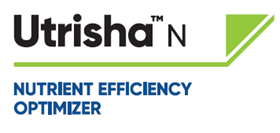Product and Agronomy Research (PAR) Results: Utrisha™ N Observations
BY Dairyland Seed Agronomy Team
Utrisha™ N Observations
Description:
The use of biological products that aid in nutrient management is becoming commonplace across the Dairyland Seed footprint. Our nitrogen management study looked at a couple of these products and we also have folks looking at these products on their own operations. Utrisha™ N by Corteva Agriscience™ was used by several folks and they were gracious enough to share their findings with us, and this study summarizes what folks saw from the product in the wild.

Utrisha N is a living organism, Methylobacterium symbioticum, that supplies supplemental nitrogen to a wide variety of plants such as corn, soybeans, alfalfa, wheat, and others. Utrisha N is applied through a foliar application and is compatible with many herbicides and fertilizers. This organism is an endophytic bacteria which means that it can live in the plant and has no negative impact on the plant, and colonizes the plant by entering through stomata. Entry through stomata means that optimum application timing is early in the day while stomata are still open from respiration. When Utrisha N lives in symbiosis with the crop plant and lives off a byproduct of cell division, methanol, and in return supplies the crop plant with ammonium (NH4+) fixed from atmospheric nitrogen (N2).
Results:
Soybeans - Illinois
- DSR-3177E™, 115,000 population, sample area 1.688 acres for both treated and untreated
- Utrisha N 71.9 bpa
- Untreated 71.8 bpa
Corn - Illinois
- DS-4510Q™ planted at 36,000 seeds per acre in 20-inch rows
- Nitrogen application-175 units of N anhydrous ammonia preplant, 50 units side dress 32-0-0.
- Utrisha N applied same day as side dress and applied with only water as carrier. Sample area 1.112 acres for each treatment. Moisture for each grain sample 19.8.
- Utrisha N 236.8 bpa
- Untreated 234.7 bpa
Soybeans – Mt. Hope, WI
|
Treatment |
Variety |
Harvest Population |
Yield adj to 13% moisture |
|
Untreated |
DSR-2188E™ |
77,000 |
75.53 |
|
Utrisha N |
DSR-2188E™ |
68,500 |
74.75 |
|
Utrisha N |
DSR-2188E™ |
77,000 |
74.47 |
|
Untreated |
DSR-2188E™ |
73,000 |
68.54 |
Corn - Wabash
|
Treatment |
Yield |
Moisture |
|
170 Units N |
186.8835 |
17.3 |
|
210 units N + Utrisha N 2x |
189.3433 |
17.2 |
|
210 units N + Utrisha N 1x |
194.5270 |
16.8 |
|
40 units N + Utrisha N 2x |
170.2332 |
17.1 |
|
40 Units N |
165.9201 |
16.8 |
|
210 Units N |
200.6636 |
17.3 |
Conclusion:
This year, in these trials, soybeans did not show a large response to the application of Utrisha N, and corn responses varied. We included this portion to show what results folks are seeing in the wild or under extreme reduced nitrogen scenarios. It is clear to see that in all of these trials nitrogen was not a limiting factor to yield. Even in the reduced nitrogen rates at Wabash, with only 40 total units of nitrogen applied with compared to 40 total units of nitrogen plus 2 applications of Utrisha N, we see a 4.31 bpa increase with the double application of Utrisha N. The application of nutrient management biological products allows for greater access to and luxury consumption of nutrients and in this case that nutrient is nitrogen which can increase yield if nitrogen is a major limiting factor to yield. It is important to remember that many factors impact yield, and in these trials, in these locations, this year nitrogen was likely not a limiting factor to yield.
 |
 |
 |
 |
 |
| Brian Weller Western Region 507.456.3034 |
Dan Ritter Central Region 219.863.0583 |
Branden Furseth Northern Region 608.513.4265 |
Mark Gibson Eastern Region 260.330.8968 |
Amanda Goffnett Eastern Region 989.400.3793 |
